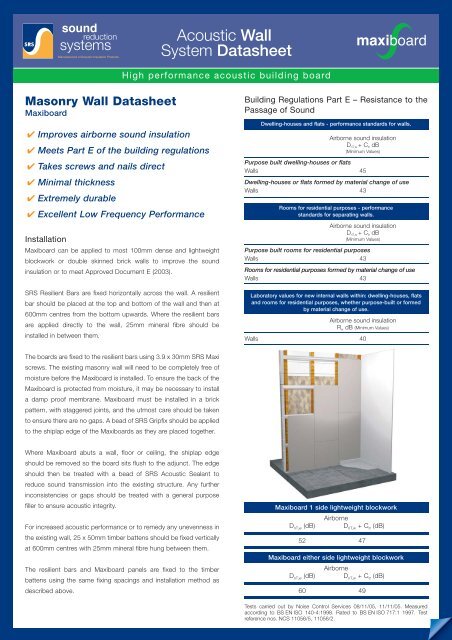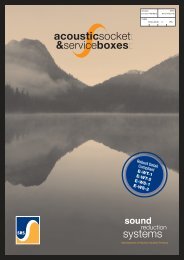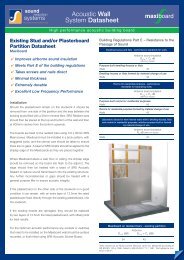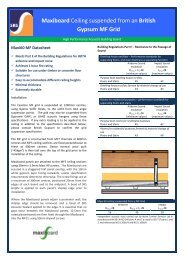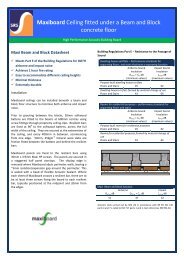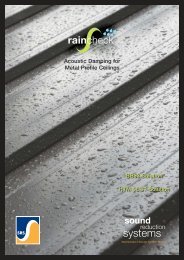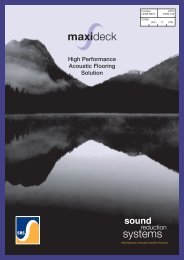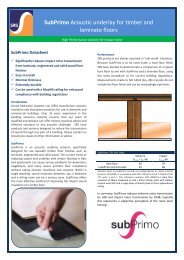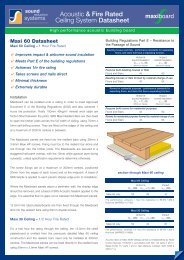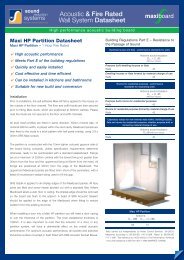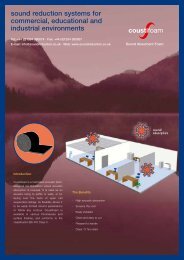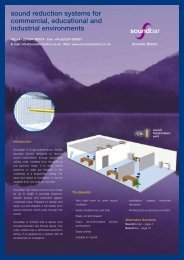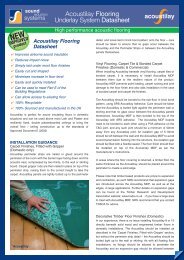Acoustic Wall System Datasheet
Maxi Masonry Walls Specification Datasheet - Sound Reduction ...
Maxi Masonry Walls Specification Datasheet - Sound Reduction ...
You also want an ePaper? Increase the reach of your titles
YUMPU automatically turns print PDFs into web optimized ePapers that Google loves.
<strong>Acoustic</strong> <strong>Wall</strong><br />
<strong>System</strong> <strong>Datasheet</strong><br />
Masonry <strong>Wall</strong> <strong>Datasheet</strong><br />
Maxiboard<br />
✔ Improves airborne sound insulation<br />
✔ Meets Part E of the building regulations<br />
✔ Takes screws and nails direct<br />
✔ Minimal thickness<br />
✔ Extremely durable<br />
✔ Excellent Low Frequency Performance<br />
Installation<br />
Maxiboard can be applied to most 100mm dense and lightweight<br />
blockwork or double skinned brick walls to improve the sound<br />
insulation or to meet Approved Document E (2003).<br />
SRS Resilient Bars are fixed horizontally across the wall. A resilient<br />
bar should be placed at the top and bottom of the wall and then at<br />
600mm centres from the bottom upwards. Where the resilient bars<br />
are applied directly to the wall, 25mm mineral fibre should be<br />
installed in between them.<br />
Building Regulations Part E – Resistance to the<br />
Passage of Sound<br />
Dwelling-houses and flats - performance standards for walls.<br />
Airborne sound insulation<br />
D nT,w + C tr dB<br />
(Minimum Values)<br />
Purpose built dwelling-houses or flats<br />
<strong>Wall</strong>s 45<br />
Dwelling-houses or flats formed by material change of use<br />
<strong>Wall</strong>s 43<br />
Rooms for residential purposes - performance<br />
standards for separating walls.<br />
Airborne sound insulation<br />
D nT,w + C tr dB<br />
(Minimum Values)<br />
Purpose built rooms for residential purposes<br />
<strong>Wall</strong>s 43<br />
Rooms for residential purposes formed by material change of use<br />
<strong>Wall</strong>s 43<br />
Laboratory values for new internal walls within: dwelling-houses, flats<br />
and rooms for residential purposes, whether purpose-built or formed<br />
by material change of use.<br />
Airborne sound insulation<br />
R w dB (Minimum Values)<br />
<strong>Wall</strong>s 40<br />
The boards are fixed to the resilient bars using 3.9 x 30mm SRS Maxi<br />
screws. The existing masonry wall will need to be completely free of<br />
moisture before the Maxiboard is installed. To ensure the back of the<br />
Maxiboard is protected from moisture, it may be necessary to install<br />
a damp proof membrane. Maxiboard must be installed in a brick<br />
pattern, with staggered joints, and the utmost care should be taken<br />
to ensure there are no gaps. A bead of SRS Gripfix should be applied<br />
to the shiplap edge of the Maxiboards as they are placed together.<br />
Where Maxiboard abuts a wall, floor or ceiling, the shiplap edge<br />
should be removed so the board sits flush to the adjunct. The edge<br />
should then be treated with a bead of SRS <strong>Acoustic</strong> Sealant to<br />
reduce sound transmission into the existing structure. Any further<br />
inconsistencies or gaps should be treated with a general purpose<br />
filler to ensure acoustic integrity.<br />
For increased acoustic performance or to remedy any unevenness in<br />
the existing wall, 25 x 50mm timber battens should be fixed vertically<br />
at 600mm centres with 25mm mineral fibre hung between them.<br />
The resilient bars and Maxiboard panels are fixed to the timber<br />
battens using the same fixing spacings and installation method as<br />
described above.<br />
Maxiboard 1 side lightweight blockwork<br />
Airborne<br />
D nT,w (dB) D nT,w + C tr (dB)<br />
52 47<br />
Maxiboard either side lightweight blockwork<br />
Airborne<br />
D nT,w<br />
(dB) D nT,w<br />
+ C tr<br />
(dB)<br />
60 49<br />
Tests carried out by Noise Control Services 08/11/05, 11/11/05. Measured<br />
according to BS EN ISO 140-4:1998. Rated to BS EN ISO 717:1 1997. Test<br />
reference nos. NCS 11056/5, 11056/2.
Fire properties:<br />
Fire propagation BS 476:Part 6: 1989 Class 0<br />
SRS Gripfix SRS <strong>Acoustic</strong> Sealant SRS Maxi Screws<br />
Surface spread of flame:<br />
BS 476:Part 7: 1997 Class 1<br />
Maxi Resilient Bar = 3m<br />
Maxiboard Dimensions:<br />
Size = 1200 x 600mm (nominal)<br />
Thickness = 17mm<br />
Maxiboard Accessories<br />
SRS <strong>Acoustic</strong> Sealant = 900ml tube<br />
Resilient Bars = 3000mm x 120 x 30mm<br />
SRS Gripfix = 310ml tube<br />
SRS Maxi Screws = 3.9 x 30mm<br />
Weight = 24kg/m 2<br />
Cutting:<br />
Best cut using circular saw with dust extraction fitted. Can<br />
also be cut using a jigsaw or hand saw fixed with a heavy<br />
duty blade.<br />
Storage: Maxiboard must be laid flat and kept dry.<br />
Maxiboard should only be stored on site if the building has<br />
been sealed and is completely dry.<br />
Finishing & Plastering Maxiboard<br />
We recommend that plasterboard be fitted over the Maxiboard and finished<br />
according to manufacturer’s instructions.<br />
SRS Ltd <strong>Acoustic</strong> Insulation <strong>Datasheet</strong>s<br />
Sound Reduction <strong>System</strong>s Ltd are experts in all areas of sound insulation.<br />
For further information on their range of products and systems for reducing<br />
sound transmission in buildings and meeting the acoustic requirements of<br />
the Building Regulations Approved Document E, please see the following<br />
datasheets, which are easily obtained by calling 01204 380074 or<br />
downloading from www.soundreduction.co.uk.<br />
Ceilings:<br />
• Maxi 60 Ceiling <strong>System</strong><br />
• Maxiboard beneath existing plasterboard<br />
• Maxiboard beneath concrete beam and block<br />
• Maxiboard on a British Gypsum MF ceiling<br />
<strong>Wall</strong>s:<br />
• Maxi HP Partition <strong>System</strong><br />
• Maxiboard installed with new/existing stud<br />
Patents & Trademarks<br />
‘Maxiboard’ and ‘Acoustilay’ are registered trade names of<br />
Sound Reduction <strong>System</strong>s Ltd. Both are patented<br />
products.<br />
Maxiboard Patent No: GB2375358<br />
Acoustilay Patent No: GB2287086<br />
Floors:<br />
• Acoustilay • Maxideck • SubPrimo<br />
If you are unsure of which product or system you require,<br />
please contact our industry leading technical department on<br />
Tel: 01204 380074 or email info@soundreduction.co.uk<br />
for free, friendly advice.<br />
Sound Reduction <strong>System</strong>s Ltd<br />
Adam St, Off Lever St, Bolton BL3 2AP<br />
Tel: +44 (0)1204 380074 · Fax: +44 (0)1204 380957<br />
E-mail: info@soundreduction.co.uk<br />
Web: www.soundreduction.co.uk<br />
Site conditions and installation standards vary. SRS cannot take responsibility for the performance of any installed system of which SRS products are only a part, or that have been<br />
installed incorrectly. Prior to installation, it is necessary to identify and eliminate possible flanking paths that may compromise the acoustic performance of any SRS product.


